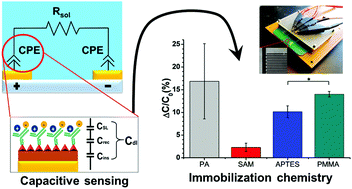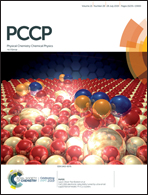Interfacial capacitance immunosensing using interdigitated electrodes: the effect of insulation/immobilization chemistry†
Abstract
With the aim of improving the reproducibility of capacitive immunosensors, we performed a comparative study of four different insulating/immobilization chemistries. Each chemistry targeted different areas of an interdigitated electrode including an alkyl thiol monolayer on the electrode surface, an amino silane monolayer on the gaps between electrodes, and conformal coatings via passive adsorption of the probe and a spin-coated layer of poly(methyl methacrylate) (PMMA). We analyzed the dielectric properties of these chemistries by comparing their capacitive behavior through equivalent circuit modeling and correlate the observed behavior with their surface characteristics by using atomic force microscopy and finite element modeling. We found that surface binding events occurring in the interdigitated electrode gaps play a major role in the overall change in capacitance. This was confirmed via finite element modeling showing an increased electric field intensity in the electrode gaps by 14%, compared to directly above the electrodes. Among the investigated surface chemistries, PMMA conformal coating produced a smooth surface (Rq roughness = 0.21 ± 0.02 nm) providing the most reproducible and stable capacitance change (15.6 ± 0.4%) in response to specific antigen–antibody binding.



 Please wait while we load your content...
Please wait while we load your content...